VALLEJO GANTNER HUT
MOUNT HOWITT WALKING TRACK HOWITT PLAINS, WELLINGTON SHIRE
-
Add to tour
You must log in to do that.
-
Share
-
Shortlist place
You must log in to do that.
- Download report
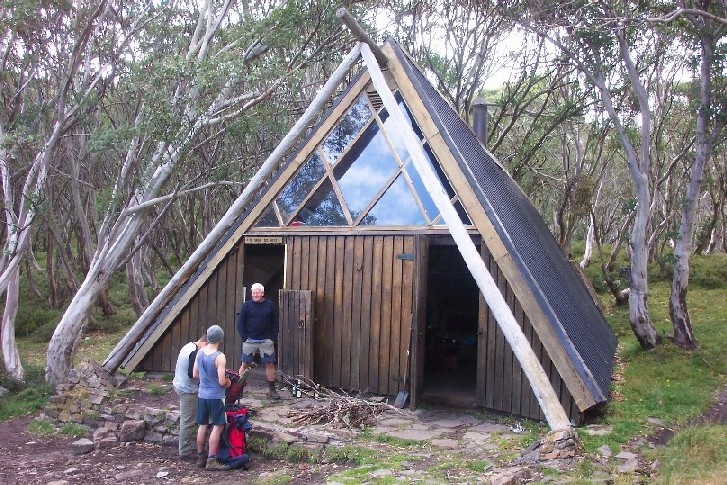

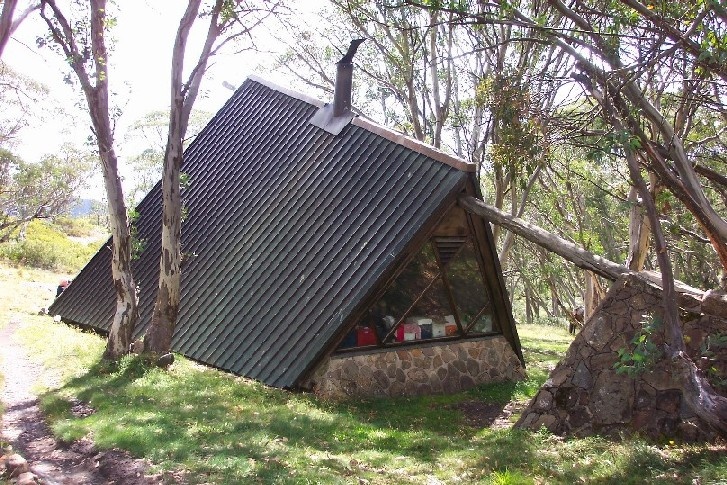
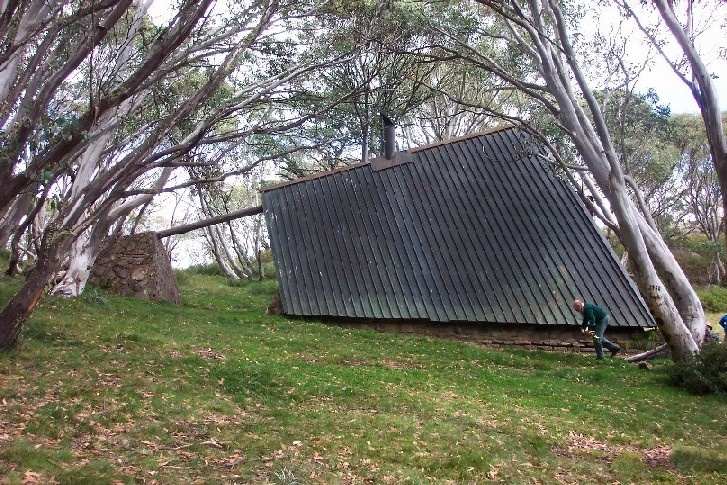



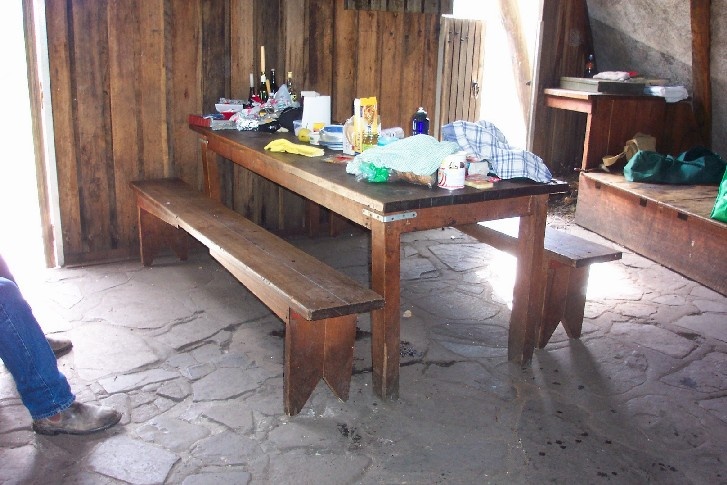



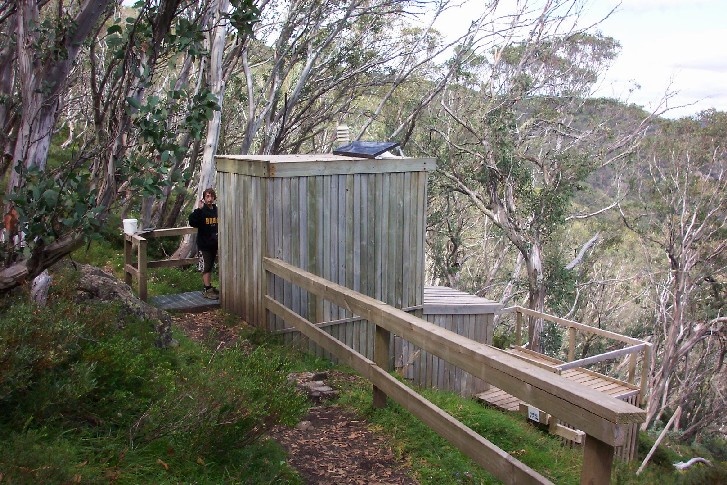

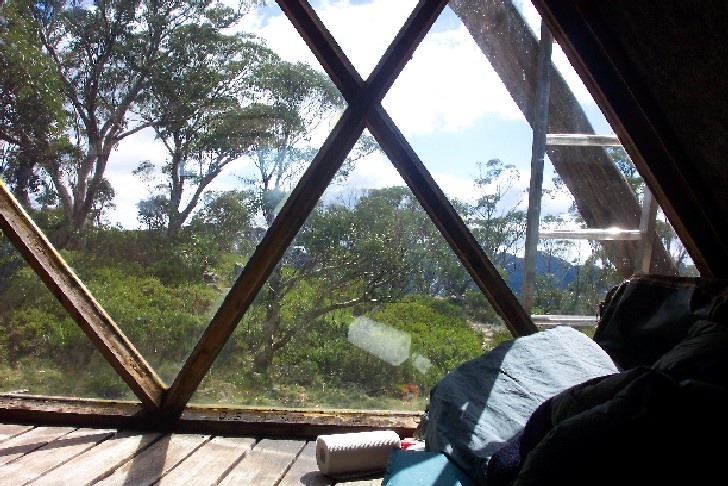
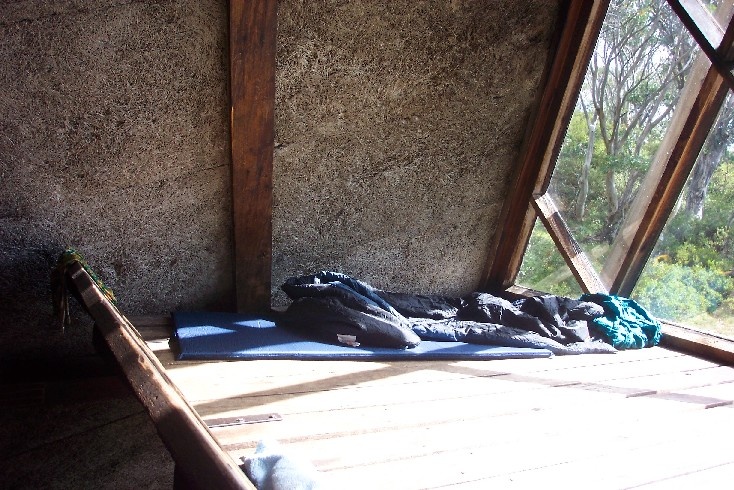
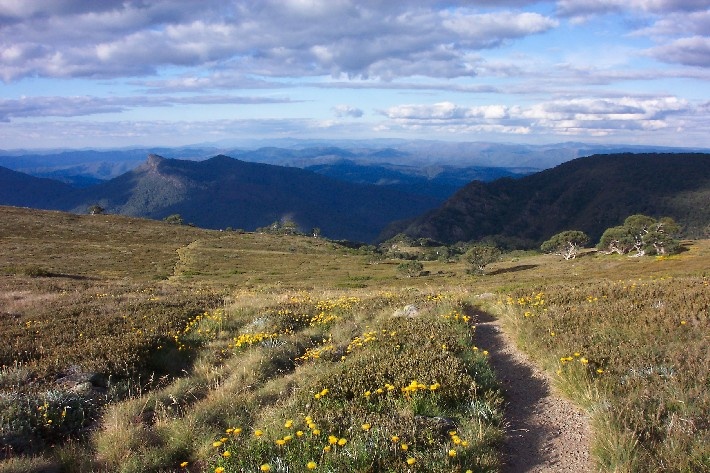
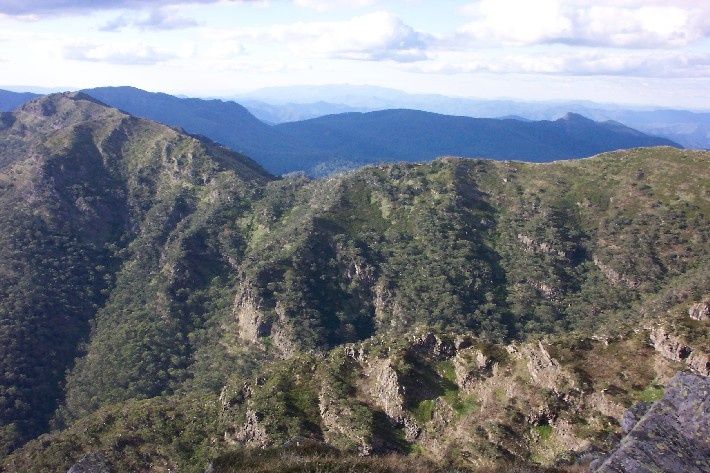

Statement of Significance
What is significant?
The Vallejo Gantner Memorial Hut is an architect-designed hut in Victoria's high country, near Mount Howitt. It was designed in 1970 by David McGlashan, of architects McGlashan & Everist, and built in 1970-71. The hut was built in memory of Vallejo Gantner, a young man who loved the mountains and who died accidentally in 1962 at the age of 19. The hut was intended for use by all comers.
The Vallejo Gantner Hut is modeled on the concept of a hiker's tent. Two gabled beams at the front hold a long ridge-pole which is anchored by a stone buttress two metres behind the hut. The strong triangular front wall faces the spectacular skyline of the Crosscut Saw. The windows are triangular or diamond-shaped glass in the gables of the front and rear walls. The roof is of copper sheeting, with no breaks in the sweep from ridge-pole to ground. The roof is lined internally with Stramit insulating board. Apart from the roof, much of the building material used is local, including sandstone, basalt and woollybutt poles, in the tradition of the cattlemen's huts.
The Gantner Hut has very high levels of visitation, due to its strategic position. The site was chosen in 1963 because it was remote from all other huts, and is amongst what many regard as the best walking country and the most spectacular mountain scenery in Victoria. The Hut provides a natural overnight stop between Mt. Howitt and the Crosscut Saw for walkers on the Australian Alps Walking Track, which was also established in the 1970s. It is also a convenient camping spot for those traveling from Mt. Howitt down into the Wonnangatta Valley. There is permanent water at Macalister Springs nearby, and firewood from the surrounding snowgums.
How is it significant?
The Vallejo Gantner Memorial Hut is of architectural, historical and social significance to the State of Victoria.
Why is it significant?
The Vallejo Gantner Memorial Hut is architecturally significant as a rare example of an architect-designed alpine hut. It is one of only three huts in the Victorian Alps designed by architects. The other is Cleve Cole Hut, designed by Malcolm McColl and built in 1937 and the Joyce Brockhoff Hut designed by Buchan, Laird and Buchan in 1949.
The Vallejo Gantner Memorial Hut is architecturally significant as a unique variant on the A-frame design, which became popular in the 1960s for ski lodges and holiday houses, but was rarely used for alpine huts. In Victoria the only other A-frame alpine hut is Diamantina Hut near Mt. Feathertop.
The Vallejo Gantner Memorial Hut is historically significant as a rare example of the practice of establishing memorial huts in the Victorian Alps. Others are Cleve Cole Hut, 1937, Charlie Derrick Hut, 1967, and Bluff Spur Hut, 1987. No new memorial huts have been permitted in the Alpine National Park since 1989.
The Vallejo Gantner Memorial Hut is historically significant as a representative example of a hut associated with the history of bushwalking as a recreational activity in Victoria, and with the expansion of outdoor education activities in the mountains in the 1970s-80s.
The Vallejo Gantner Memorial Hut is socially significant to a large number of bushwalkers and visitors to the mountains, as reflected in the logbook entries and volunteer commitment to the hut?s maintenance. The heavily used hut is demonstrative of the growing popularity of outdoor activities such as bushwalking, horse-riding and cross-country skiing in Victoria's mountain country.
-
-
VALLEJO GANTNER HUT - History
Contextual History
The hut was built by the combined efforts of many people. Vallejo’s mother, Neilma Gantner, and a group of Vallejo’s closest school-friends, worked closely with the architect on the design of the hut, for example suggesting that it turn 90o north to face the Crosscut Saw, rather than facing downhill towards the springs. For two years, volunteers collected stones and rock from the area, and sorted them into two piles: flat (for the floor, the platform, the walls) and not flat (for the foundations). The Vallejo Gantner Hut was officially opened in April, 1971. The capital cost of the hut was borne by Vallejo’s family, and his family and friends were involved throughout its design and construction. The story of Vallejo’s life, the history of the building of the hut and those who helped, and the opening service in 1971, are told in typescript at the front of each logbook.
It is historically significant in having played a major role in opening up the mountains to a wider, more urban, public. It was opened in April 1971, at the height of public interest in outdoor activities. Schools were starting to develop outdoor education programs; outdoor clothing and equipment were soon to become big business. Bushwalking was possibly at its peak, and commercial horse-riding tours in large numbers came some years later.
It has associative significance in being connected to the Myer family, through Vallejo’s mother, Neilma Gantner. It is part of the long philanthropic tradition of the Myer family, as can be seen in the hut’s purpose, being there for all to use.
The Gantner Hut is one of very few memorial huts in the Australian Alps in Victoria. No more memorial huts have been built since 1987, when an application to build a memorial refuge hut was rejected by the Federation of Vic. Walking Clubs, the Ski Touring Association of Vic and the Victorian National Parks Association. “Reasons included threat to the fragile environment, (no more huts on the High Plains), damage to snow trails, and potential hazard luring inexperienced skiers by a false sense of security. “ [Victorian Alpine Huts Survey 2004-2005. Draft report for public comment .p. 262) This marked the end of building memorial huts in the Victorian Alps. NSW Parks Service also has a policy of no memorial huts.
The hut site is on a short north-south ridge which connects the Howitt Plains, Clover Plain and the Wonnangatta Spur to the Mt. Howitt range and the Crosscut Saw. A short walk from the hut (5-10 minutes) brings one to the edge of the Terrible Hollow, looking E to the Devil’s Staircase, and north of that to the Viking, the Razor and Mount Despair. The Crosscut Saw is a jagged ridge of mountain peaks curving west of the Terrible Hollow to Mt. Howitt, taking in places like Mt. Speculation, Horrible Gap, and Mount Buggery. This, as the names testify, is some of the hardest walking country in the state.
That a hut is needed there is shown by the number of visitors: these are variously estimated from those who signed the logbook as 10,000 to 20,000 p.a. That the hut is loved is shown by comments in the book, such as those from 2004-2005 below::
My Grandpa helped build this hut and its great to be here!!
Kate Dennis, 3 Mar. 2004
Fantastic view from Howitt. Crew a bit rough.
Dave, 18.11.04
Have had my eyes opened, don’t wish to return to where I’ve come from. This is living.
Natalia Swietlik
Thank you to whomever cleans the loft window – beautiful clear view of the stars.
Anon
Ventured here for a few days trying to find my soul. I think I’ve found it.
Anon, Nov. 04.
In 1996, the Vallejo Gantner Hut was included in Graeme Butler’s Victorian Alpine Huts Heritage Survey, Graeme Butler & Associates, 1996. Graeme Butler assessed its significance as State-level, for its architectural and historical values. He says:
“It is also historically significant as the focus of many of Melbourne’s arts and academic community of the 1960s-70s in the effort to build it and at its opening.”
The Hut Committee helps Ranger Wayne McCallum to maintain the hut, and visits it annually to carry out repairs and maintenance.
References
Typescript history at the hut: “The Building of the Vallejo Gantner Hut 1970 and 1971”. Includes the record of the service opening the hut in April 1971. Also held by the State Library of Victoria.
Butler, Graeme. Victorian Alpine Huts Heritage Survey, Graeme Butler & Associates, 1996, pp. 114 – 117. (unpublished report).
DCNR Lands Wonnangatta County Plan ‘Public Refuge Hut ‘ on grant 2 acres, GG1971, p.1881; RS 9477; CP77591 shown east of Mt. Howitt.
Hueneke, Klaus. Huts in the Victorian Alps: and the people who built and care for them. Palmerston, A.CT, Tabletop Press, 2003.
Magnussen, Fiona. Victoria’s alpine heritage huts of the High Plains: Bogong, Dargo and Hotham regions. Henty, NSW, Staffback Pty Ltd, 2003.
Siseman, John. Walking the Bogong High Plains and adjacent peaks, [by] John Siseman and Algona guides, Montrose, Vic., Algona Publications, 12978.
Siseman, John. Wonnangatta-Moroka National Park. Northcote, Vic., John Siseman in association with Algona Publications, 1985.
VALLEJO GANTNER HUT - Permit Exemptions
General Exemptions:General exemptions apply to all places and objects included in the Victorian Heritage Register (VHR). General exemptions have been designed to allow everyday activities, maintenance and changes to your property, which don’t harm its cultural heritage significance, to proceed without the need to obtain approvals under the Heritage Act 2017.Places of worship: In some circumstances, you can alter a place of worship to accommodate religious practices without a permit, but you must notify the Executive Director of Heritage Victoria before you start the works or activities at least 20 business days before the works or activities are to commence.Subdivision/consolidation: Permit exemptions exist for some subdivisions and consolidations. If the subdivision or consolidation is in accordance with a planning permit granted under Part 4 of the Planning and Environment Act 1987 and the application for the planning permit was referred to the Executive Director of Heritage Victoria as a determining referral authority, a permit is not required.Specific exemptions may also apply to your registered place or object. If applicable, these are listed below. Specific exemptions are tailored to the conservation and management needs of an individual registered place or object and set out works and activities that are exempt from the requirements of a permit. Specific exemptions prevail if they conflict with general exemptions. Find out more about heritage permit exemptions here.Specific Exemptions:General Conditions: 1. All exempted alterations are to be planned and carried out in a manner which prevents damage to the fabric of the registered place or object. General Conditions: 2. Should it become apparent during further inspection or the carrying out of works that original or previously hidden or inaccessible details of the place or object are revealed which relate to the significance of the place or object, then the exemption covering such works shall cease and the Executive Director shall be notified as soon as possible. Note: All archaeological places have the potential to contain significant sub-surface artefacts and other remains. In most cases it will be necessary to obtain approval from Heritage Victoria before the undertaking any works that have a significant sub-surface component. General Conditions: 3. If there is a conservation policy and plan approved by the Executive Director, all works shall be in accordance with it. Note: The existence of a Conservation Management Plan or a Heritage Action Plan endorsed by Heritage Victoria provides guidance for the management of the heritage values associated with the site. It may not be necessary to obtain a heritage permit for certain works specified in the management plan. General Conditions: 4. Nothing in this declaration prevents the Executive Director from amending or rescinding all or any of the permit exemptions. General Conditions: 5. Nothing in this declaration exempts owners or their agents from the responsibility to seek relevant planning or building permits from the responsible authorities where applicable. Regular Site Maintenance : The following site maintenance works are permit exempt under section 66 of the Heritage Act 1995, a) regular site maintenance provided the works do not involve the removal or destruction of any significant above-ground features or sub-surface archaeological artefacts or deposits; b) the maintenance of an item to retain its conditions or operation without the removal of or damage to the existing fabric or the introduction of new materials; c) cleaning including the removal of surface deposits, organic growths, or graffiti by the use of low pressure water and natural detergents and mild brushing and scrubbing; d) repairs, conservation and maintenance to plaques, memorials, roads and paths, fences and gates and drainage and irrigation. e) the replacement of existing services such as cabling, plumbing, wiring and fire services that uses existing routes, conduits or voids, and does not involve damage to or the removal of significant fabric. Note: Surface patina which has developed on the fabric may be an important part of the item's significance and if so needs to be preserved during maintenance and cleaning. Note: Any new materials used for repair must not exacerbate the decay of existing fabric due to chemical incompatibility, obscure existing fabric or limit access to existing fabric for future maintenance. Repair must maximise protection and retention of fabric and include the conservation of existing details or elements. Weed and Vermin Control : The following weed and vermin control activities are permit exempt under section 66 of the Heritage Act 1995, a) Weed and vermin control activities provided the works do not involve the removal or destruction of any significant above-ground features or sub-surface archaeological artefacts or deposits; Note: Particular care must be taken with weed and vermin control works where such activities may have a detrimental affect on the significant fabric of a place. Such works may include the removal of ivy, moss or lichen from an historic structure or feature, or the removal of burrows from a site that has archaeological values. Public Safety and Security : The following public safety and security activities are permit exempt under section 66 of the Heritage Act 1995, a) public safety and security activities provided the works do not involve the removal or destruction of any significant above-ground structures or sub-surface archaeological artefacts or deposits; b) the erection of temporary security fencing, scaffolding, hoardings or surveillance systems to prevent unauthorised access or secure public safety which will not adversely affect significant fabric of the place including archaeological features; c) development including emergency stabilisation necessary to secure safety where a site feature has been irreparably damaged or destabilised and represents a safety risk to its users or the public. Note: Urgent or emergency site works are to be undertaken by an appropriately qualified specialist such as a structural engineer, or other heritage professional. Signage and Site Interpretation : The following Signage and Site Interpretation activities are permit exempt under section 66 of the Heritage Act 1995, a) signage and site interpretation activities provided the works do not involve the removal or destruction of any significant above-ground structures or sub-surface archaeological artefacts or deposits; b) the erection of non-illuminated signage for the purpose of ensuring public safety or to assist in the interpretation of the heritage significance of the place or object and which will not adversely affect significant fabric including landscape or archaeological features of the place or obstruct significant views of and from heritage values or items; c) signage and site interpretation products must be located and be of a suitable size so as not to obscure or damage significant fabric of the place; d) signage and site interpretation products must be able to be later removed without causing damage to the significant fabric of the place; Note: The development of signage and site interpretation products must be consistent in the use of format, text, logos, themes and other display materials. Note: Where possible, the signage and interpretation material should be consistent with other schemes developed on similar or associated sites. It may be necessary to consult with land managers and other stakeholders concerning existing schemes and strategies for signage and site interpretation. Minor Works : Note: Any Minor Works that in the opinion of the Executive Director will not adversely affect the heritage significance of the place may be exempt from the permit requirements of the Heritage Act. A person proposing to undertake minor works may submit a proposal to the Executive Director. If the Executive Director is satisfied that the proposed works will not adversely affect the heritage values of the site, the applicant may be exempted from the requirement to obtain a heritage permit. If an applicant is uncertain whether a heritage permit is required, it is recommended that the permits co-ordinator be contacted.Regular maintenance works including regular treatment of the external timbers
Repairs to the platform and flooring of the hut which replace like material with like
Remediation of heavily-used tracks with rubber matting or similar
Replacement of the toilet superstructure, provided the replacement is on the same site with the same orientation
Routine replacement of the logbook by Parks Victoria; the old logbook to be sent to the La Trobe Library Manuscripts Section, SLV.
Materials conservation of logbooks held at the La Trobe Library Manuscripts Section, SLV
VALLEJO GANTNER HUT - Permit Exemption Policy
The significance of the Vallejo Gantner Hut depends on the contrast between its geometric architectural structure and its simple natural setting. The registered site includes the hut, the clearing, the lookout point facing the Crosscut Saw, the Macalister Springs and the camp site up behind the hut. Inside the hut, it includes the interior with all fixtures, including the two rows of wood-boxes, the ladder, the table and two benches, cupboards, logbook and the metal box containing it, all fixed shelving, and the sleeping loft. The logbooks recording visitors to the hut have been kept since 1971. All but the current logbook are held by the State Library of Victoria in its Manuscripts collection. The registered building includes the rock platform the hut sits on, the sloping ridge-beams, the two front poles supporting it, and the rock buttress anchoring the ridge-pole.
Any further addition of structures within the registered area would diminish the clarity of the relationship between the Hut, the surrounding trees and campsite, the lookout and the Springs. Any additional structures in the clearing or among the surrounding trees could potentially diminish the naturalness of the hut in its setting, and obscure its relationship with the Snowgum woodland, campsite, lookout and Springs. The high authenticity of the hut could potentially be compromised by structural additions or removals to the exterior or the interior. The furniture, ladder, doors, fireplace and chimney are all of key significance to the hut, and any alteration, damage, removal from or addition to them could potentially diminish the hut's significance and our understanding of it.
-
-
-
-
-
VALLEJO GANTNER HUT
 Victorian Heritage Register H0046
Victorian Heritage Register H0046
-
1 Barkly Avenue
 Yarra City
Yarra City -
1 Clifton Street
 Yarra City
Yarra City -
1 Laura Place
 Yarra City
Yarra City
-
-
Tours involving this place See all tours
09/07/20
STAR EXTENDED BATTERY - CLEAR HILLS HUT RUIN - KEEP DRY HUT - HOWQUA GAP HUT & LOGGING CAMP - RAZORBACK/PURCELL'S HUT COMPLEX - Eucalyptus pauciflora - ALTA AND NELSON BATTERY SITE - VALLEJO GANTNER HUT
Public contributions
Tours involving this place See all tours
09/07/20
STAR EXTENDED BATTERY - CLEAR HILLS HUT RUIN - KEEP DRY HUT - HOWQUA GAP HUT & LOGGING CAMP - RAZORBACK/PURCELL'S HUT COMPLEX - Eucalyptus pauciflora - ALTA AND NELSON BATTERY SITE - VALLEJO GANTNER HUT










